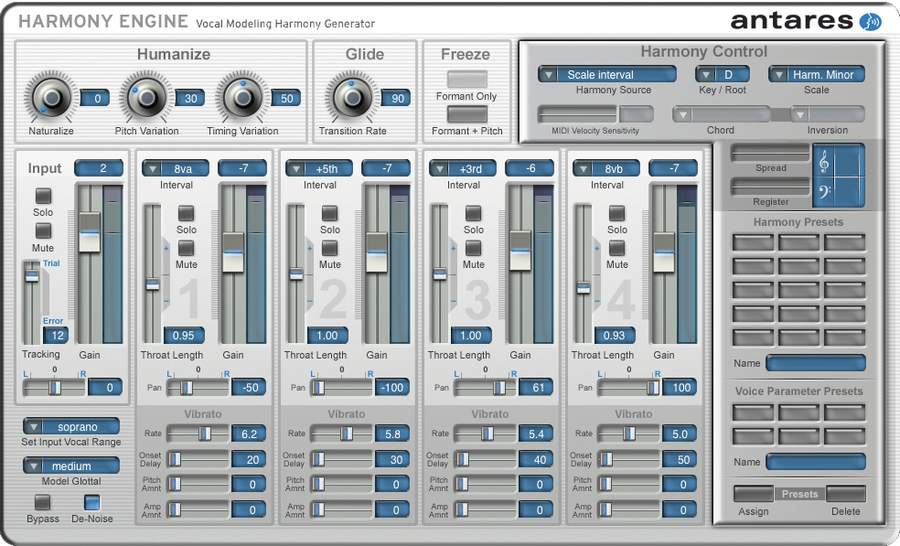MusicRadar Verdict
Although Harmony Engine is an interesting release, it's a little more 'virtual' than it is 'reality' at the moment.
Pros
- +
Four independent harmonies. Different methods of operation. Tools for increasing authenticity.
Cons
- -
Can sound artificial.
MusicRadar's got your back
There aren't many plug-ins that have changed the music industry. One that most certainly has, though, is Antares Auto-Tune.
Until its release, sessions with vocalists for whom perfect tuning was more miss than hit were less than fun. Auto-Tune was a revelation, and it's become a studio staple. Antares is now trying to make harmony generation as simple as pitch shifting with its Harmony Engine plug-in.
Harmony Engine (HE) provides you with four independent voices, each of which uses a mono or stereo source file as a 'trigger'. To get up and running, you simply insert HE as a channel strip plug-in over your lead vocal file - you're then free to 'arrange' these voices in a number of ways.
The easiest option is to let HE do the work for you. Enter an offset for each voice, either above or below the original pitch at a fixed interval, and HE will respond by 'singing' the appropriate chord over each note.
Unfortunately, the pitfalls here are obvious, with the likelihood that sooner or later you'll end up with a harmony note that will clash horribly, so while this option is useful for introducing you to HE's approach, it won't suit most applications.
Fortunately, this isn't the end of HE's story.
Advanced use
Harmonies can be generated via MIDI in three separate ways. Firstly, you can enter a series of basic MIDI chords and HE will use these as a means to generate harmonies.
If you want more control, you can use the MIDI Omni mode to directly 'play' the HE, with each voice responding to MIDI input in real time. In fact, you can get close to vocoder-style functionality.
For the ultimate in control, you can prerecord four separate MIDI parts, which can then become independent triggers for each of HE's harmony lines.
Once you've chosen the notes for your arrangement, HE offers a selection of tools that can be used to reduce 'artificial' elements. 'Throat' is modelled on the Human vocal tract and changes the character of each harmony independently. There are also global controls such as 'Humanise' (borrowed from Auto-Tune), which enable slight pitch and timing variations.
Summary
Antares has proved that, when it comes to vocal processing, it's got something special to say. But while there's no doubt that it's on to something with Harmony Generator, it's not ready to set the world alight.
The problem is that Harmony Engine doesn't yet sound sufficiently 'real'. While the technology is fascinating, we wouldn't rely on it to flesh out a vocal arrangement on any project where authenticity was valued above all else.
Will it suit your work? You be the judge: have a listen to our audio examples and make a decision:
MusicRadar is the number 1 website for music makers of all kinds, be they guitarists, drummers, keyboard players, djs or producers...
GEAR: We help musicians find the best gear with top-ranking gear round-ups and high- quality, authoritative reviews by a wide team of highly experienced experts.
TIPS: We also provide tuition, from bite-sized tips to advanced work-outs and guidance from recognised musicians and stars.
STARS: We talk to musicians and stars about their creative processes, and the nuts and bolts of their gear and technique. We give fans an insight into the actual craft of music making that no other music website can.
“A synthesizer that is both easy to use and fun to play whilst maintaining a decent degree of programming depth and flexibility”: PWM Mantis review
“I feel like that song had everything we needed to come back with”: Bring Me The Horizon’s Lee Malia on Shadow Moses, its riff and the secrets behind its tone, and why it was the right anthem at the right time
“I said, ‘Are we sure we can write a song about death?’”: The story of Mike + The Mechanics' classic No.1 The Living Years











